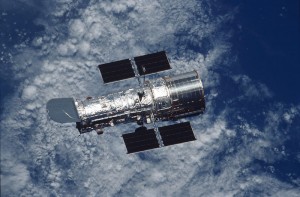Astronomers finally have been able to solve a 40-year mystery thanks to the Hubble Space Telescope.
For over four decades astronomers have been trying to find the origin of the Magellanic Stream, a long ribbon of hydrogen gas clouds that stretch almost halfway around our own Milky Way galaxy.
The Magellanic Stream is connected to the Large and Small Magellanic Clouds, which are two small and irregular galaxies that are orbiting the Milky Way.
These irregular galaxies – those that do not have a distinctive regular shape – are among the Milky Way’s closest galactic neighbors and have long provided stargazers with spectacular astronomical images, even more so since advanced telescopes like the Hubble went online.
The Magellanic Stream was discovered with radio telescopes in the early 1970’s and since then astronomers have wanted to know whether the stream’s origination came from one or both of the clouds.
Using recent Hubble observations, two teams of astronomers found that most of the stream’s gas pulled away from the Small Magellanic Cloud about 2 billion years ago. They also found that a second region of the stream was created a little more recently from the Large Magellanic Cloud.
The astronomers, led by Andrew J. Fox of the Space Telescope Science Institute in Maryland, were able to make their findings with the Hubble’s Cosmic Origins Spectrograph.
This device aboard the space telescope allowed them to determine the amount of heavy elements – anything heavier than helium – such as oxygen and sulfur at several areas alongside the Magellanic Stream. They were able to detect those heavy elements by observing the way they absorbed ultraviolet light.
One team said that they found a small amount of oxygen and sulfur along most of the stream, which matched the levels of the elements that was in the Small Magellanic Cloud when the stream first formed. The team was surprised to discover a much higher level of sulfur in an area of the stream that’s closer to the Magellanic Clouds.
“We’re finding a consistent amount of heavy elements in the stream until we get very close to the Magellanic Clouds and then the heavy element levels go up,” said Fox. “This inner region is very similar in composition to the Large Magellanic Cloud, suggesting it was ripped out of that galaxy more recently.”
Fox went on to explain that the only way his team was able to measure the quantities of the heavy elements in the stream was by using the ultraviolet observational method. This is something he said could only be done with space telescopes like the Hubble, but not earth based telescopes since our atmosphere tends to absorb ultraviolet light.
Compared to other satellite galaxies of the Milky Way, the researchers pointed out that so far, both Magellanic Clouds have been able to hold on to their supplies of gas and are still able to create new stars because they’re more massive than others.
But that is something that they say probably won’t last forever since the Magellanic Clouds are getting closer to our own galaxy and are feeling, more and more, the gravitational effects of their much larger neighbor.
This growing gravitational pull is forcing each of the two clouds to smash into halos of gas that surround them, which in turn are pushing their own supplies of gas out. All of that along with a “gravitational tug-of-war” between the Magellanic Clouds themselves is leading to the production of a gas stream.
The researchers say that eventually the gassy stream being produced by the two satellite galaxies may pour onto the Milky Way’s stellar disk, which will fuel the creation of new stars. This mix of fresh gas is part of a process that produces star formation in a galaxy. Astronomers wanted to know the origin of that wayward gas so that they could better understand how galaxies make new stars.
“We want to understand how galaxies like the Milky Way strip the gas from small galaxies that fall into them and then use it to form new stars,” said Fox. “This seems like it’s an episodic process. It’s not a smooth process where a slow stream of gas comes in continuously. Instead, once in a while a large gas cloud falls in. We have a way of testing that here, where two galaxies are coming in. We’ve shown which of them is producing the gas that ultimately will fall into the Milky Way.”
The research and findings made by the astronomers in this investigation were outlined in two papers that were published in a recent issue of the “Astrophysical Journal.” Fox was the lead author of one paper, while Philipp Richter of Germany’s University of Potsdam served as the lead author of the second paper.


























Comments are closed.